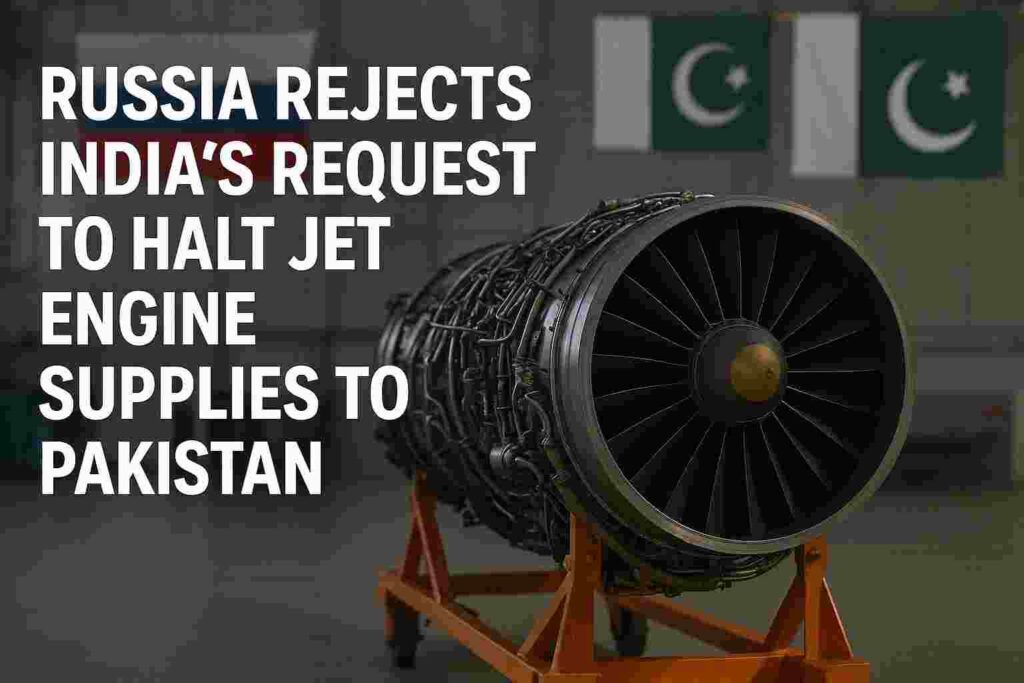In the intricate web of global diplomacy, where old friendships clash with cold economic realities, a recent decision by Russia has sent shockwaves through South Asia. As of early October 2025, Moscow has firmly rejected India’s repeated pleas to suspend the delivery of advanced RD-93MA jet engines to Pakistan for its JF-17 Thunder fighter jets. This isn’t just a technical arms deal—it’s a seismic shift that exposes the fragility of long-standing ties and could redefine aerial dominance in one of the world’s most volatile regions. Buckle up as we unpack the backstory, the bold move by Russia, and the ripple effects on India-Pakistan relations.
Roots of the Rift: From Cold War Comrades to Conditional Partners
The India-Russia defense bond dates back to the 1970s, forged in the fires of the Cold War. Russia (and its Soviet predecessor) has supplied India with everything from MiG fighters to nuclear submarines, making it New Delhi’s go-to for over 60% of its military imports. But the JF-17 saga adds a twist. Co-developed by Pakistan and China since 2007, these lightweight multirole jets rely on Russian RD-93 engines for their punch. India has protested this arrangement for years, arguing it arms a nuclear-armed rival across a heavily militarized border.
Tensions boiled over in May 2025 during Operation Sindoor, a short-lived but fierce India-Pakistan clash along the Line of Control. JF-17s, humming with RD-93 power, were at the forefront of Pakistani strikes, prompting India to double down on its appeals. In June, External Affairs Minister S. Jaishankar confronted his Russian counterpart in Moscow, framing the supplies as a direct threat to regional stability. Yet, the $500 million contract—inked in 2024 between Russia’s United Engine Corporation (UEC)-Klimov and Pakistan’s Aviation City—marched forward unabated.
Moscow’s Calculus: Survival Trumps Sentiment
Why snub a key ally like India? Russia’s playbook here is brutally pragmatic. Crippled by Western sanctions post-Ukraine invasion, its arms export coffers have shrunk by 70%, leaving a gaping hole in state revenues. Enter Pakistan: a burgeoning market that’s climbed into Russia’s top 10 arms buyers, with bilateral deals topping $1 billion. The RD-93MA, an upgraded beast delivering 93 kN of thrust (up 12% from the base model), promises better agility, heavier payloads, and superior high-altitude ops—tailor-made for the Himalayan skirmishes that define Indo-Pak aerial duels.
Layer on Russia’s ironclad alliance with China, the JF-17’s other parent, and the incentives multiply. Scuttling the deal could fracture that partnership, a risk Moscow can’t afford in its quest for a multipolar world order. Indian critics, from Congress stalwart Jairam Ramesh to defense analysts, are fuming. Ramesh’s pointed barb—”Why bolster Pakistan’s arsenal while we pour billions into S-400s?”—captures the betrayal felt in Delhi. It’s a wake-up call: In geopolitics, loyalty has an expiration date when dollars (or rubles) are on the line.
The Tech Edge: Supercharging Pakistan’s Skies
At the heart of this drama is the RD-93MA engine—a compact marvel that transforms the JF-17 Block III into a formidable contender. Clocking in at a fraction of the cost of Western jets ($25-30 million per unit), these upgraded birds now sport AESA radars for stealthy target lock-ons, PL-15 beyond-visual-range missiles, and cutting-edge electronic warfare gear. The result? A fleet of 50+ jets that could neutralize India’s numerical edge in dogfights, especially in the treacherous skies over Kashmir.
For Pakistan’s Air Force, it’s a force multiplier against India’s Su-30MKI and Rafale squadrons. Imagine: enhanced thrust for quicker climbs, better fuel sipping for longer patrols, and resilience in extreme conditions. Deliveries are trickling in now, with full integration expected by mid-2026. This isn’t hyperbole—simulations from think tanks like the Observer Research Foundation suggest it tilts the airpower balance by 15-20% in Pakistan’s favor for short-range engagements.
India’s Counterplay: Diversify or Die
New Delhi isn’t standing still. The snub has turbocharged its push for self-reliance under the Atmanirbhar Bharat banner. Expect accelerated Rafale orders from France (aiming for 114+ units), deeper US ties via GE-HAL co-production of F-414 engines for the Tejas Mk2, and ramped-up indigenous R&D for the Advanced Medium Combat Aircraft (AMCA). Prime Minister Modi’s team is also courting Israel for drone tech and electronic upgrades, signaling a multi-vendor future.
Yet, the sting lingers. This episode erodes trust in Russia, potentially delaying joint ventures like the BrahMos missile upgrades. On the diplomatic front, India might lean harder into the Quad alliance, using it as leverage in future talks with Moscow.
Looking Ahead: A New Era of Uneasy Equilibriums
Russia’s rejection of India’s request marks more than a transactional arms sale—it’s a harbinger of fractured alliances in a sanction-squeezed world. For South Asia, it amps up the arms race, where every engine rev could echo in the next border flare-up. Will this push India toward full-spectrum diversification, or force a renegotiation of its Russian ties? Only time—and perhaps the next MEA briefing—will tell.
As the JF-17s roar to life with Russian hearts, one thing’s clear: In the game of thrones over the subcontinent’s skies, no one’s loyalty is absolute. Stay tuned; the jet streams are just getting turbulent.
Also read:


